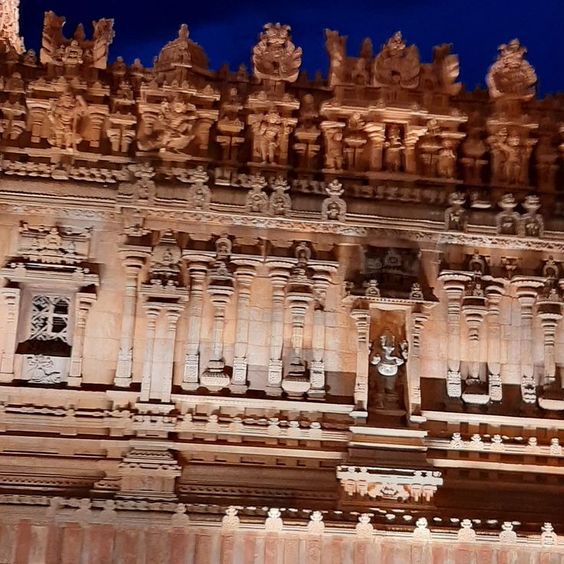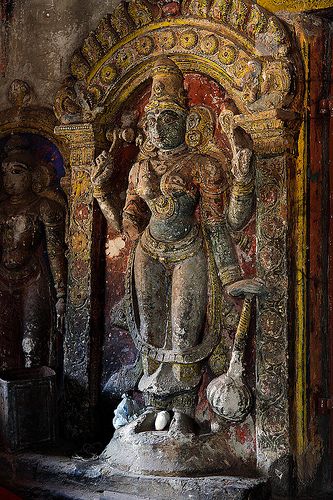Located on the southern bank of Cauvery river , in Thanjavur , Tamil Nadu , Brihadeswhar temple is an epitome of Tamil architecture . It is dedicated to Lord Shiva and is one of the most visited temple in India. The temple was constructed under Raja Raja Chola around 1010 AD and it is also called Raja Rajeshwaram , meaning the God of Raja Raja.
Built using granite in the Dravidian style , it is one of the largest Hindu temple with one of the largest Shiv ling in the world.
The name Brihadeshwar means ‘ Great Lord or great Shiva’.
History
Between 850 CE and 1280 CE , Cholas emerged as the ruling power in the southern kingdoms. When they gained their supremacy in south , they focussed on the architecture of their kingdom.
After visiting the Pallava Rajasimha Temples in Kanchipuram, Raja Raja had a dream of constructing a large temple for Shiva.
As a result , the Brihadeshwar temple was built in Thanjavur , which is the capital of Chola dynasty.
After the thirteenth century the Chola rule was overthrown by the Pandya dynasty , which was further overtaken by the Vijaynagar kingdom. At last the kingdom was possessed by the British government.
The temple has been renovated and repaired multiple times for the last 1000 years.
Architecture

The temple is built using the Dravidian style of architecture.
A big structure of temple is mounted on strong man made mounds or bricks . The main attraction of the temple is the 216 ft. tall Vimanam ( tower) and the gopuram.
The temple is divided into five spaces :
(i). Sri Vimanam – The sanctum with the tower.
(ii). Nandi Mandapam- The Nandi hall in the front.
(iii).Community hall – Mukh Mandapam
(iv).Mahamandapam – The gathering hall
(v).Antrala- Pavelion connecting the hall with the sanctum.
The architects and artisans of the Chola era were skilled in building large buildings on stones , maintaining the traditions of southern architecture using decorative elements. The temple faces east and is surrounded by wide walls that was once moat filled with water.
It is the first temple that was completed using the granite stone.
Deities
Shiva is the main deity in the form of a huge 2.9 ft high Shivlinga , which is the largest monolithic sculpture in India.
The lower sanctorum has four walls , where sculptures of various Hindu traditions like Shaktism and Vaishnavism are made. These sculptures and deities are as follows:
(i).East– Lingodbhava , the iconic presentation of Shiva, in standing form emerging from a Shivling and two Dwarpalas (door guards).
(ii).South– Bhikshatana (Shiva as supreme beggar), Virbhadra, Dakshinamurthi, Kalantaka ,Natrajar and two Dwarpalas.
(iii).West– Half Shiva – half Vishnu called Harihara , Lingodbhava, Chandrashekhara without prabhavali, Chandrashekhara with prabhavali, plus two dvarapalas.
(iv).North- Ardhanarishwar , Gangadhara without Parvati, Pashupata-murti, Shiva-alingana-murti, plus two dvarapalas.
On the second floor there is a sculpture of Tripurantakar form of Shiva.
Above it there is 13 storey tall tower called Shri Vimana, which has a 80 ton block of granite stone on top of it.
The temple walls have numerous inscriptions on it , which mostly describes the gifts and donations by the kings to the temple priests , or to the residents of the city.
There are 64 inscription of Raja Raja Chola, 29 of Rajendra Chola 1 , and other inscriptions of the Pandyan and Nayak rulers.
Significance of Brihadeshwara Temple

The inscriptions have names of the people that were employed by the temple authorities and paid by them including the temple priests , tailors, jwellers ,lamplighters etc .
The temple also employed Devdasis , who were female dancers and singers of devotional hymns . The temple gave grants to the locals of the city and distributed food to pilgrims and saints.
This shows that since its construction , the temple had been an important centre for charity and spirituality .
There are paintings from the Chola empire and Nayak rulers all around the temple which are bright and colorful , depicting the rule and culture of Chola dynasty.
Not just spiritually vibrant , the temple is also a role model and a civil engineering marvel . The techniques used in the construction are very unique , and it took quite less time of six years to build such a large and grand structure.
Completion of 1000 years of Construction
On 26 September 2010 , the temple completed 1000 years of its construction .
To celebrate this event , various cultural events were held in the city, the classical dance forms of Tamil Nadu were performed and the region turned into a cultural and spiritual hub for two days.
Various cabinet ministers of Finance Department of India , issued new currency with the image of Brihadeshwar temple on it.
The postal department also released a stamp of the Vimana of the temple.
For 1000 years , the temple has been an iconic representation of the south Indian culture and traditions . It is an epitome of architecture and engineering and has been declared as a World Heritage site by UNESCO.
The temple is currently managed by Babaji Bhonsle , the head of Thanjavur Maratha Royal family.